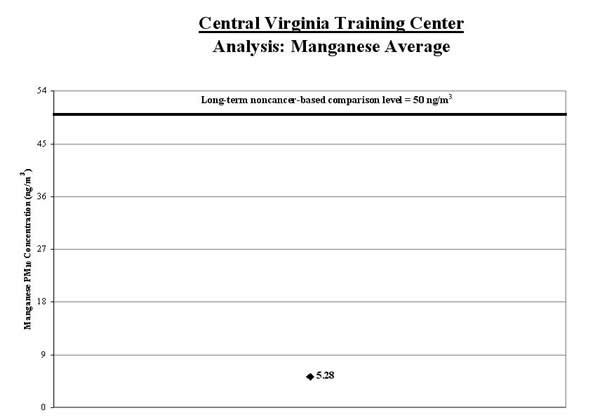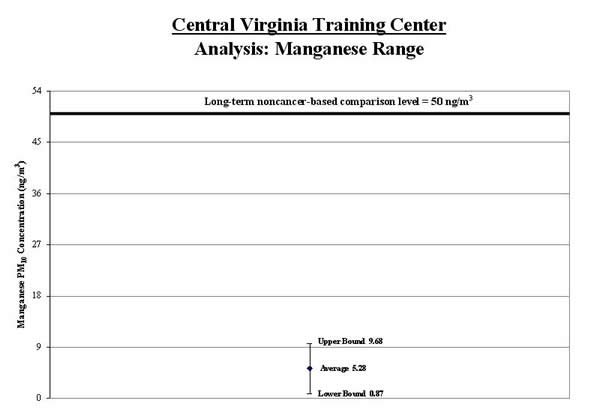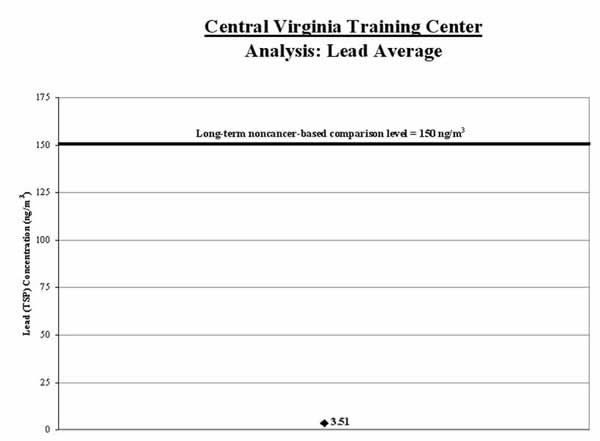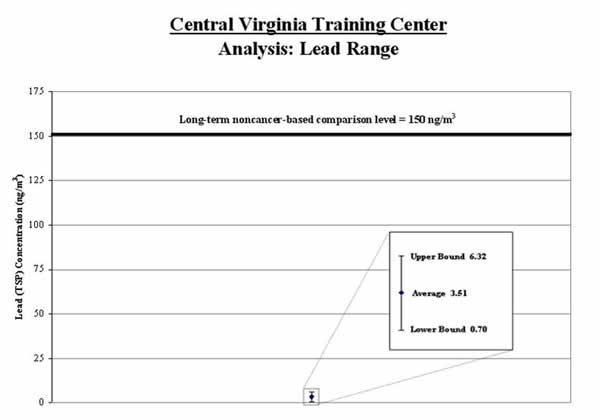Assessing Outdoor Air Near Schools
Central Virginia Training Center and Solid Rock Christian Academy - Madison Heights, VA
Results and Analysis of EPA’s monitoring
EPA selected this school for monitoring because it is located near a foundry which produces cast iron pipe which is a source of air toxics emissions. For the purposes of this study, results from the air monitoring at Central Virginia Training Center are considered to be indicative of conditions at the nearby Solid Rock Christian Academy. Computer models were used to determine which air toxics may be present at elevated levels in the outdoor air near the school. These models showed that manganese and lead could be present in the air around the school and prompted EPA to test to see if the levels present may be of concern.
| Primary Findings | Levels of manganese in the air at the school are below levels of concern. Additionally, levels of lead, a pollutant for which there are national standards for ambient (outdoor) air, are below the level of the national standard for protection of public health. |
| Key Pollutants Monitored | Manganese. Inhalation may affect the nervous system if people are exposed to high levels. Lead. Inhalation and ingestion may affect the developing nervous system if people are exposed to high levels. |
| Next Steps | EPA will not extend air toxics monitoring at the Central Virginia Training Center at this time . EPA remains concerned about emissions from sources of air toxics and continues to work to reduce those emissions across the country, through national rules and by providing information and suggestions to assist with reductions in local areas. The Virginia Department of Environmental Quality (VADEQ) will continue to oversee the industrial facilities in the area through air permits and other programs. Nearby industrial facilities, including the one responsible for targeting this school, are regulated by air permits and by applicable federal regulations such as New Source Performance Standards (NSPS) and Maximum Achievable Control Technology (MACT) standards. VADEQ will be initiating lead monitoring at this site as part of the national ambient air quality standard (NAAQS) for lead. |
Summary of Study Approach and Findings
Approach:
- A monitor collected air samples from August 23 through October 16, 2009 at the Central Virginia Training Center in Madison Heights, VA. For the purposes of this study, results from the air monitoring at Central Virginia Training Center are considered to be indicative of conditions at the nearby Solid Rock Christian Academy.
- We posted individual air sample results on this website throughout the monitoring period to keep your community informed during the monitoring period.
- During the monitoring period, we evaluated the monitored concentrations to see if there was a concern from short-term exposures (e.g., several weeks).
- When the monitoring was complete, we analyzed the results to see if there was a concern from long-term exposures (over a lifetime).
- Also, when the monitoring was complete, we evaluated all the air samples from the on-site monitor. We also evaluated information on wind speed and wind direction from a weather monitor at the school, along with historical weather information and information about a nearby source of manganese and lead emissions.
Findings:
- Our analysis found that levels of manganese in the air at the school are below levels of concern for long-term exposure. Additionally, levels of lead, a pollutant for which there are national standards for ambient (outdoor) air, are below the national standard for protection of public health.
- The concentrations of manganese and lead measured at the school are lower than those suggested by the information that helped identify this school for monitoring.
- The analysis indicates that manganese and lead concentrations in the air near the school are influenced by a nearby source.
- The process to identify schools for monitoring relied on emissions estimates and other information. Ambient air monitoring at the school allowed measurement of what was actually in the air.
- The most recently available manganese and lead emissions estimates for the nearby facility from the Toxics Release Inventory (TRI) arelower than the estimates used to identify this school for monitoring.
- The facility was operating below its more usual conditions of production (60% vs. 90%) during the monitoring period. The low measurements at this school indicate that an increase in facility emissions to those associated with 90% of capacity would not change the conclusions reached above.
- EPA will not extend air toxics monitoring at the Central Virginia Training Center.
- Click here for additional information
How We Analyzed the Information We Collected at this School
The analysis considered whether the information collected at the school might raise concerns for the health of children or adults at the school. We looked at the following types of information:
- Measured manganese and lead concentrations and information on manganese and lead
- Measured wind direction and wind speed at the school
- Information about nearby sources of manganese and lead emissions
Analysis of Measured Manganese Concentrations:
1. Calculate the average: We calculated the average of the manganese measurements (shown by the black diamond in the graph below). We compared this average to the long-term comparison level (thick line on the graph below). The long-term comparison level represents the level of manganese in the air that is below levels associated with health concerns, even if someone breathed air containing manganese at that level all day, every day over their lifetime.
Result: The average manganese level for the samples collected was well below the long-term comparison level. The health concern is low.

2. Calculate a range: To account for varying air concentrations of manganese, we calculated a range around the average. We did this by estimating high and low values that the longer-term concentrations might reach using common statistical tools. We compared the highest point in the range (called the “upper bound”) to the long-term comparison level.
Result: The high end of the range is lower than the comparison level. The health concern is low.

Analysis of Measured Lead Concentrations:
1. Calculate the average: We calculated the average of the lead measurements (shown by the black diamond in the graph below). We compared this average to the comparison level (thick line on the graph below). The comparison level is the level of the national ambient air quality standard (NAAQS) for lead.
Result: The average lead level for the samples collected was well below the comparison level. The health concern is low.

2. Calculate a range: To account for varying air concentrations of lead, we calculated a range around the average. We did this by estimating high and low values that the longer-term concentrations might reach using common statistical tools. We compared the highest point in the range (called the “upper bound”) to the comparison level.
Result: The high end of the range is lower than the comparison level. The health concern is low.

Analysis of Measured Wind Direction and Wind Speed at the School
We took measurements of wind direction and speed every day during the sample period. We took special note of the wind speed and direction on the days we took measurements of manganese and lead.
| What we looked at | What we found |
| We looked at whether the wind data taken on the days we took measurements of manganese and lead are similar or different from the wind patterns during the entire sampling period. | We found the wind patterns taken on the days we took measurements of manganese and lead to be similar to those observed during the entire sampling period. |
| We looked at whether the wind pattern during the sampling period is reflective of regional wind pattern over the long term. | Although we lack long term wind data at the monitoring station, the wind patterns at the NWS site during the sampling period are generally not similar to the historical long-term wind flow pattern at that location. This suggests that, on a regional scale, the 2‑month sampling period is not representative of year-round wind patterns. |
Analysis of Information on Nearby Source of Manganese and Lead Emissions
| What we looked at | What we found |
| Whether we could determine if the source was operating as usual during the monitoring period | This facility was operating at approximately 60% of its normal capacity during the monitoring period. |
| The concentrations of manganese and lead measured at the school are lower than those suggested by the information that helped identify this school for monitoring. | |
| The nearby source of manganese and lead has an air operating permit issued by the State of Virginia that includes operating requirements. |
Additional Information
Technical Report for School: Assessing Outdoor Air Near Schools: Central Virginia Training Center (Madison Heights, VA) (PDF) (30pp, 622k). The technical report is geared toward risk assessors, risk managers, and other regulatory agencies.
Background on School Monitoring Effort
